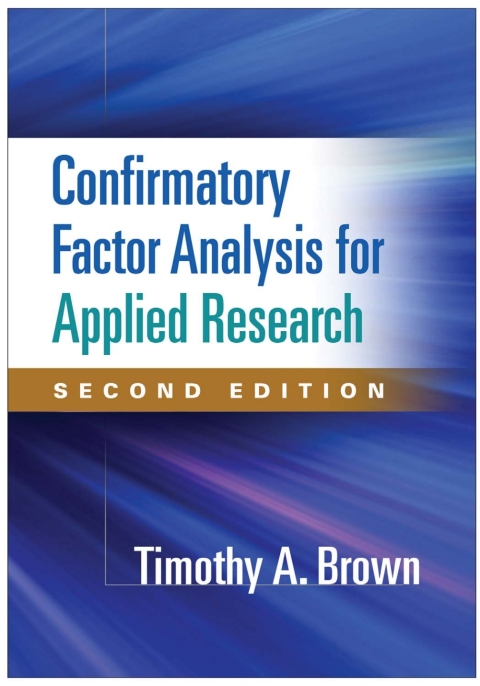Description
Efnisyfirlit
- Half Title
- Methodology in the Social Sciences
- Title
- Copyright
- Dedication
- Series Editor’s Note
- Preface
- Contents
- 1. Introduction
- Uses of Confirmatory Factor Analysis
- Psychometric Evaluation of Test Instruments
- Construct Validation
- Method Effects
- Measurement Invariance Evaluation
- Why a Book on CFA?
- Coverage of the Book
- Other Considerations
- Summary
- 2. The Common Factor Model and Exploratory Factor Analysis
- Overview of the Common Factor Model
- Procedures of EFA
- Factor Extraction
- Factor Selection
- Factor Rotation
- Factor Scores
- Summary
- 3. Introduction to CFA
- Similarities and Differences of EFA and CFA
- Common Factor Model
- Standardized and Unstandardized Solutions
- Indicator Cross‑Loadings/Model Parsimony
- Unique Variances
- Model Comparison
- Purposes and Advantages of CFA
- Parameters of a CFA Model
- Fundamental Equations of a CFA Model
- CFA Model Identification
- Scaling the Latent Variable
- Statistical Identification
- Guidelines for Model Identification
- Estimation of CFA Model Parameters
- Illustration
- Descriptive Goodness‑of‑Fit Indices
- Absolute Fit
- Parsimony Correction
- Comparative Fit
- Guidelines for Interpreting Goodness‑of‑Fit Indices
- Summary
- Appendix 3.1. Communalities, Model-Implied Correlations, and Factor Correlations in EFA and CFA
- Appendix 3.2. Obtaining a Solution for a Just-Identified Factor Model
- Appendix 3.3. Hand Calculation of FML for the Figure 3.8 Path Model
- 4. Specification and Interpretation of CFA Models
- An Applied Example of a CFA Measurement Model
- Model Specification
- Substantive Justification
- Defining the Metric of Latent Variables
- Data Screening and Selection of the Fitting Function
- Running CFA in Different Software Programs
- Model Evaluation
- Overall Goodness of Fit
- Localized Areas of Strain
- Interpretability, Size, and Statistical Significance of the Parameter Estimates
- Interpretation and Calculation of CFA Model Parameter Estimates
- CFA Models with Single Indicators
- Reporting a CFA Study
- Summary
- Appendix 4.1. Model Identification Affects the Standard Errors of the Parameter Estimates
- Appendix 4.2. Goodness of Model Fit Does Not Ensure Meaningful Parameter Estimates
- Appendix 4.3. Example Report of the Two-Factor CFA Model of Neuroticism and Extraversion
- 5. Model Revision and Comparison
- Goals of Model Respecification
- Sources of Poor‑Fitting CFA Solutions
- Number of Factors
- Indicators and Factor Loadings
- Correlated Errors
- Improper Solutions and Nonpositive Definite Matrices
- Intermediate Steps for Further Developing a Measurement Model for CFA
- EFA in the CFA Framework
- Exploratory SEM
- Model Identification Revisited
- Equivalent CFA Solutions
- Summary
- 6. CFA of Multitrait–Multimethod Matrices
- Correlated versus Random Measurement Error Revisited
- The Multitrait –Multimethod Matrix
- CFA Approaches to Analyzing the MTMM Matrix
- Correlated Methods Models
- Correlated Uniqueness Models
- Advantages and Disadvantages of Correlated Methods and Correlated Uniqueness Models
- Other CFA Parameterizations of MTMM Data
- Consequences of Not Modeling Method Variance and Measurement Error
- Summary
- 7. CFA with Equality Constraints, Multiple Groups, and Mean Structures
- Overview of Equality Constraints
- Equality Constraints within a Single Group
- Congeneric, Tau‑Equivalent, and Parallel Indicators
- Longitudinal Measurement Invariance
- The Effects Coding Approach to Scaling Latent Variables
- CFA in Multiple Groups
- Overview of Multiple‑Groups Solutions
- Multiple‑Groups CFA
- Selected Issues in Single‑ and Multiple‑Groups CFA Invariance Evaluation
- MIMIC Modeling (CFA with Covariates)
- Summary
- Appendix 7.1. Reproduction of the Observed Variance–Covariance Matrix with Tau-Equivalent Indicato
- 8. Other Types of CFA Models: Higher‑Order Factor Analysis, Scale Reliability Evaluation, and Form
- Higher‑Order Factor Analysis
- Second‑Order Factor Analysis
- Schmid–Leiman Transformation
- Bifactor Models
- Scale Reliability Estimation
- Point Estimation of Scale Reliability
- Standard Error and Interval Estimation of Scale Reliability
- Models with Formative Indicators
- Summary
- 9. Data Issues in CFA: Missing, Non‑Normal, and Categorical Data
- CFA with Missing Data
- Mechanisms of Missing Data
- Conventional Approaches to Missing Data
- Recommended Strategies for Missing Data
- CFA with Non‑Normal or Categorical Data
- Non‑Normal, Continuous Data
- Categorical Data
- Other Potential Remedies for Indicator Non‑Normality
- Summary
- 10. Statistical Power and Sample Size
- Overview
- Satorra–Saris Method
- Monte Carlo Approach
- Summary
- Appendix 10.1. Monte Carlo Simulation in Greater Depth: Data Generation
- 11. Recent Developments Involving CFA Models
- Bayesian CFA
- Bayesian Probability and Statistical Inference
- Priors in CFA
- Applied Example of Bayesian CFA
- Bayesian CFA: Summary
- Multilevel CFA
- Summary
- Appendix 11.1. Numerical Example of Bayesian Probability
- References
- Author Index
- Subject Index
- About the Author
- Blank Page






Reviews
There are no reviews yet.